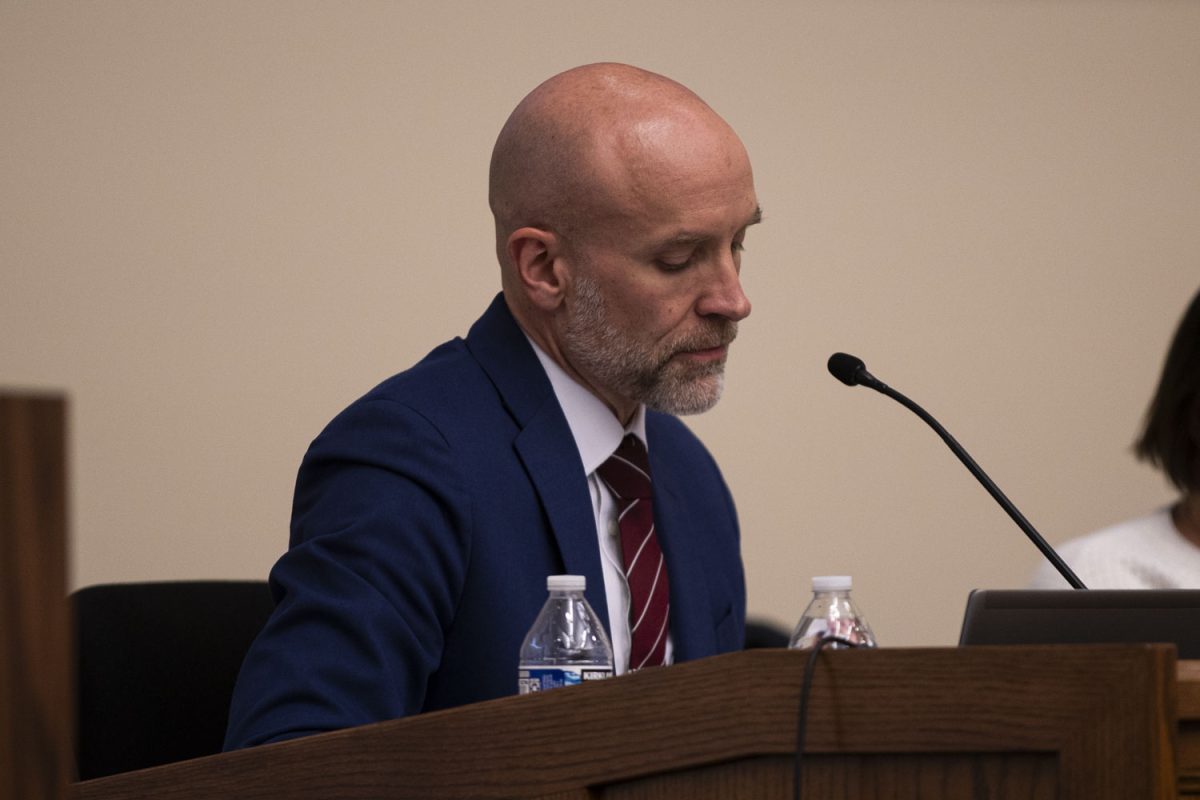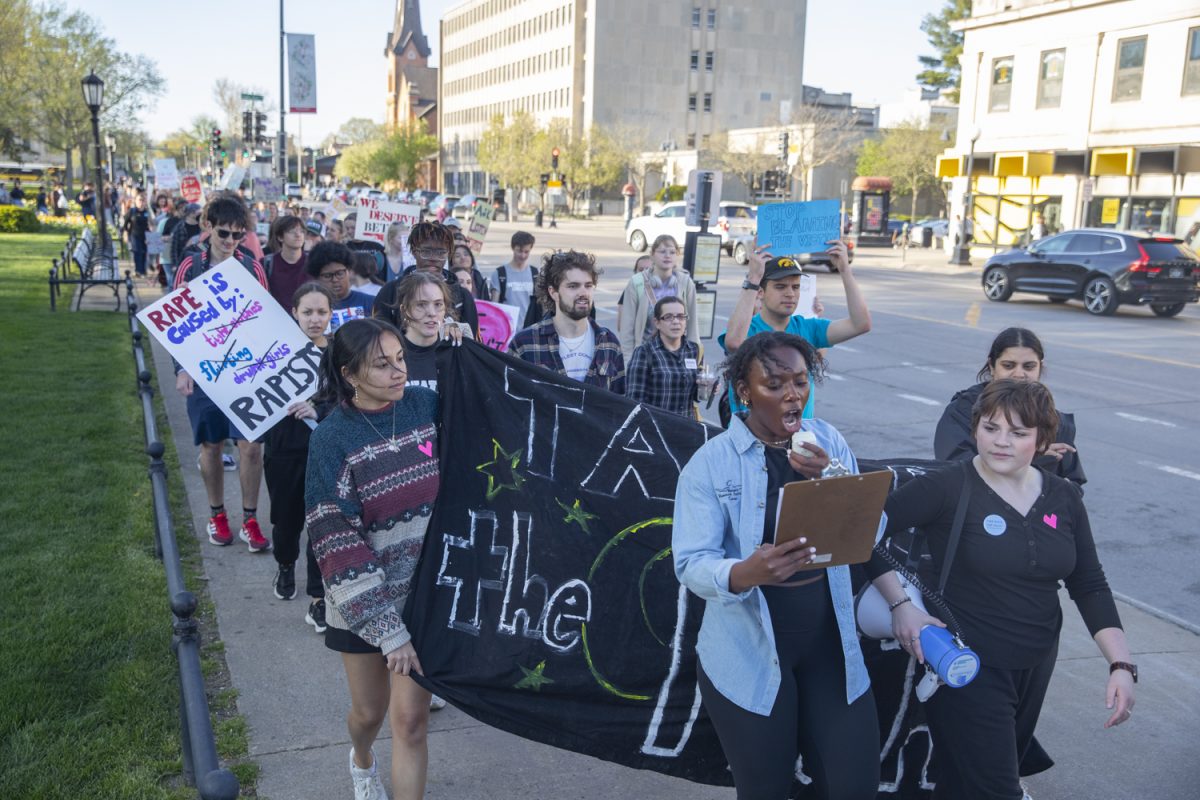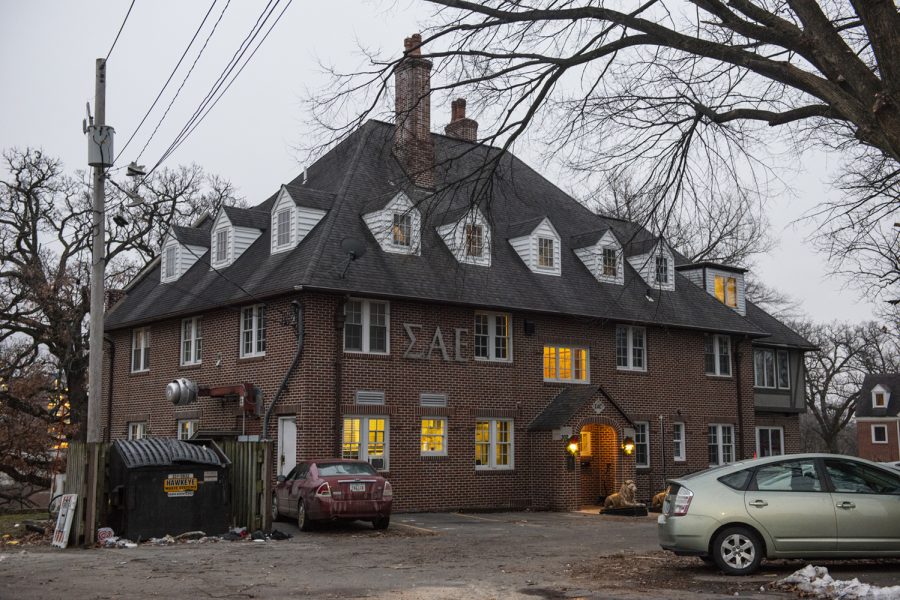The radio screeches. A loud voice fills the Dubuque Street ambulance hub.
Two paramedics hasten to their vehicle.
Lights. Sirens. Full throttle.
The ambulance speeds to One-Eyed Jakes. They find a college-age man crumpled and abandoned on the curb, his body immobilized by alcohol.
All around, bar-goers watch and yell and catcall. Paramedics hoist the prone body onto a stretcher, strap him down, and load him into the back of the brightly lit ambulance.
Normally, it’s a one-patient ride. But not tonight.
Paramedic Darrin Hayes adds another man at the same stop, this one too drunk to speak. He sways silently on the vehicle’s long, black bench as the ambulance bumps the short distance to the UI Hospitals and Clinics.
The first man vomits, turning the crisp white stretcher sheets shades of brown and green. Hayes is barely fazed. He and the 37 other paramedics see it all the time.
“They’re not just getting drunk, they’re getting belligerently drunk to the point where they are unresponsive,” said 14-year Johnson County Ambulance Service paramedic and longtime Field Supervisor Bob Libby.
A Daily Iowan investigation involving a study of alcohol statistics, student behavior, nearly a dozen hours riding along with ambulances, and more than 20 interviews found that UI students are getting substantially more intoxicated than in recent years, commonly imbibing dangerously high and sometimes lethal levels. The study found that:
• The average range of blood-alcohol concentrations for students with alcohol-related violations referred to Health Iowa, a branch of the UI Student Health Service, rose from 0.13-0.17 to 0.18-0.25 in the most recent five-year period. That level can result in a high risk of injury or blackouts, even death.
• The number of binge drinkers continues to increase, with women catching up with men. In a spring 2009 university survey, the increase in female binge drinkers doubled the increase seen in males since spring 2007. Eighty-one percent of men and 69 percent of women reported consuming five or more drinks in one sitting during the previous two weeks, according to the survey.
• Alcohol-related ambulance calls to downtown are up 21.4 percent, a jump from 238 to 289 in the last five years, according to data compiled by Professor Emeritus John Neff, who has studied local crime and alcohol for the last 10 years.
• The amount of dangerous drinking has become so severe that the number of calls are putting a strain on the ambulance service. It has been hit with a 37 percent increase in overall calls to downtown, a jump of nearly 200 in five years. A large percentage of those calls come in at similar times during the late night and early morning, when the action in the downtown bars and parties peaks.
“There gets to be a tipping point,” said former UI Provost Peter Nathan, a nationally known expert on alcoholism. If the trend continues, “what will happen is there will be a rash of serious crime, or there will be some deaths, and the City Council will do something draconian — or the university will try to do something very, very strict. And those things would not be successful.”
The campus, surrounded by a city where the number of liquor licenses has mushroomed by 140 percent since 1983, has struggled with underage and binge drinking. Surveys frequently place the university among the “best” party schools.
Binge-drinking rates among UI students tower over those at most other universities. What authorities believe is alcohol-induced male-on-male violence has recently heightened safety concerns throughout the community.
The city and university are addressing unsafe drinking through tough new ordinances and regulations, increased education, and class-scheduling changes. They also mounted a joint front in March in the Partnership for Alcohol Safety.
But the dramatic increase in drunkenness among students and the additional calls to the ambulance service add a element of urgency for dealing with the problem.
On weekend nights, young ambulance passengers are often blacked out, bloodied, vomit-drenched, screaming, crying, angry, and confused. They have drunk themselves to the hospital.
Along for the ride
It’s a Code 3, the most severe. In a West Side dorm, women peer out of their rooms into the hallway, where a crowd of paramedics and police gathers.
An 18-year-old sits on the floor in her room. Her chin is covered in blood from a fall earlier that night. Outside, another distraught woman rushes through the hallway to the stairwell and begins wailing.
“Some very emotional ladies,” a resident assistant quips.
An officer in the room attempts to give the woman a breath test. “You’re not in trouble. You’re not in trouble,” he says reassuringly. She is surrounded by police, paramedics, and firefighters.
The woman sits, not speaking. She didn’t know where she was, paramedics later said.
After failing twice to blow hard enough to activate the breath test, she finally registers a blood-alcohol concentration of 0.299 — an amount that slows her breathing and could potentially stop her gag reflex, causing her to choke on her vomit and possibly die.
“All right, it’s time to go to the hospital,” a paramedic says.
Once back in the ambulance, Chris Couch, a UI medical student who was training to become a paramedic at the time, asks for the woman’s birthday. She doesn’t respond.
Lying on the stretcher, her eyes well with tears as Couch takes her blood pressure. She lets out a faint cry as an IV needle pierces her skin. Paramedics need to fill her body with a saline solution to offset the dangerous levels of alcohol in her bloodstream.
It’s a short, expensive trip, costing at least $634. The basic fee for emergency ambulance transport is $534, but the use of an IV makes it an advanced life-support call.
A few weeks later, her father calls Johnson County Ambulance Service Director Steve Spenler. The father is angry about the ride, contending she didn’t need it. Spenler receives calls similar to this several times a year. Parents are furious about the price tag — until he tells them how much their children had drunk, he said.
“We’re seeing kids that need to be under somebody’s care and quite often need a transport to the university emergency room and probably even have to spend the night, maybe, in the Intensive Care Unit,” Spenler said. “I mean, they’re that intoxicated.”
Risking injuries and blackouts
Outside the Summit Bar and Restaurant in the early hours of a September Saturday, paramedics find a bloodied student with a large laceration over his left eye. Moments earlier, he had been punched in the face. The 18-year-old says he doesn’t know why.
“It is what it is,” he repeats, rocking and staring blankly at the medical equipment tucked neatly in the ambulance cabin. Blood dots his Hollister shirt and khaki shorts.
“How long have you been drinking?” paramedic Cody Jacobsen asks.
“Since freshman year,” he says, holding a piece of gauze against his gash.
Jacobsen chuckles. The man says he had been drinking for about two and half hours and hadn’t consumed that much — around 12 or 13 beers. That’s more than most students put down on any given night.
In a university survey this year, male students reported consuming an average of nine drinks during the last time they partied, up from seven in 2007. Females reported an average of six, one more than two years ago. Drinking that much within two hours constitutes binge drinking.
After a short trip across the river, paramedics walk the dazed man into the hospital through the ambulance garage. The paramedics return twice that night, with two more college-age men suffering head wounds. The first, discovered near hotelVetro, has a large laceration on the back of his head. A man sucker-punched him for checking out his girlfriend, the guy says.
Another has a deep cut on his face. He tells paramedics he doesn’t need to go to the hospital. He has a better idea: Find the person who punched him. It doesn’t matter to him that he might wind up with a scar for the rest of his life.
“Do you have a medical degree?” asks Hayes.
“I used to,” retorts the student with a heavy tongue. His friend giggles. “I feel I can make an accurate decision.”
“Dude, you’re not making any sense,” Hayes says. “Are you telling me you want to have a gash?”
The man eventually concedes.
Hayes is used to the back talk. They all are. Paramedics get chewed out, spit on, swung at — and in the case of three-and-a-half-year veteran Dieter Friton, proposed to.
Friton, originally from Munich, Germany, who came to Iowa City for love, politely declined. He says the woman broke down in tears and asked him why he didn’t think she was pretty. Minutes earlier she had belted out songs and laughed, he recounted in a heavy German accent.
Downtown calls similar to these occupy a huge chunk of paramedics’ time. Busy weekend nights have forced the ambulance service to add an extra two-paramedic shift during peak hours.
“It takes all of our resources and sticks them downtown,” Spenler said.
One Thursday night, the service ran 12 calls between midnight and 5 a.m.
“In the middle of the night, that’s quite a few,” Libby said. It drains paramedics, he said. They typically work 24-hour shifts and try to get bits of sleep here and there. Getting sleep on the weekends used to be common.
Now it’s rare.
Still, given their resources, paramedics are adamant that they are able to serve the county.
‘The need is more out there’
Around 3 a.m. one weekend morning, paramedics arrive at a downtown apartment-complex parking lot. A man lies sprawled out atop a Toyota Camry. Orange, blue, and purple wristbands encircle his forearm.
He smells homeless, paramedic Kristina Swanson later commented.
Jacobsen shakes him and tells him to open his eyes. He doesn’t. They load him into the ambulance.
“Have you ever had an IV?” Jacobsen asks, pricking his arm. The man jerks back. His eyes remain shut.
“God, f— kid,” he says.
It’s not until Jacobsen sticks a tube up the man’s nose that he awakens.
“Ow,” the man yells. “Oh my god, f— you.”
As the ambulance bounces, he becomes belligerent, ripping the IV out of his arm. He says he doesn’t need help. “I’m being very, very,” he struggles, “very, very coherent.”
The man tears off the restraints, standing in the ambulance as it pulls into the hospital garage. Blood drips over the floor. Swanson hates blood over the floor.
Eventually, she calms the man down, and he enters the hospital.
Minutes after cleaning up, the paramedics are going again. This time it’s to Lone Tree, approximately a 20-mile drive. An elderly man has fallen. He’s in pain and spitting up something black. Paramedics don’t know what’s wrong.
While they spend considerable time downtown, paramedics serve all of the county’s roughly 128,000 residents spread over 614 square miles. It’s a population that has grown by more than 15 percent between 2000 and 2008, according to the U.S. Census Bureau.
Last year, Spenler requested extra funding for staffing, but the Johnson County Board of Supervisors rejected it. He asked again this fall. Supervisors say they’re trying to hold the line on expenditures, asking all departments to cut 2 percent. There is only a slim chance that the department will get the extra funds, Supervisor Pat Harney said.
While calls across the county are down this fall, the numbers have increased downtown.
“The need is more out there,” Libby said.
Addressing the problem
The university and the city have tried to combat binge drinking for years, and for years, the consumption rate has continued to climb.
The Stepping Up Project was a major past effort that experts say was largely unsuccessful because it lacked substantial interaction with the community. The group organized in the mid-90s and received several grants to create more recreational programs and try to implement a new policy. Though never officially disbanded, it petered out around 2007.
In 2006, the university created AlcoholEdu, a program that mandates students take a two-part online course that discusses the effects of drinking alcohol. The program appears to be having a positive influence on students’ drinking habits. Students who participated reported having lower rates of binge drinking, fewer blackouts, and less risky behavior, among other improvements, said Angela Reams, a program administrator.
The university also has moved more classes to Fridays. A yet-to-be-published study by Michael Takacs, a clinical assistant professor of emergency medicine, shows that the action might be working.
Twenty-five percent fewer students were seen at UIHC with alcohol-related emergencies on Thursday nights and Friday mornings last school year than the previous one, Takacs said.
The city has also been looking for solutions. Community members have long discussed making bars 21-only. But in 2007, the measure went to a vote and lost by a slim margin after students and other opponents mobilized.
City councilors recently upped the punishment for bars caught serving alcohol to underage patrons, recommending that the state deny three downtown bars’ liquor-license renewals because of high numbers of underage drinking tickets. Their owners are contesting the ordinance both with the Iowa Alcoholic Beverages Division and in the local district court.
Perhaps most sweeping in what it hopes to accomplish is the communitywide effort Partnership for Alcohol Safety, established by the Provost’s Office last spring.
Such committees have sprung up at several universities nationwide, and many experts view them as effective methods in combating excessive drinking.
“There is no magic bullet,” said UI Provost Wallace Loh. “It will take the involvement of everybody. This is everybody’s problem.”
But since the committee was formed, it has only met twice. Many of the six subcommittees have met two or three times, and they are still in the preliminary, information-gathering stage.
The goal of all the efforts is clear: Change the drinking culture. But how?
No university — let alone one with some of the highest binge-drinking rates in the country — has successfully conquered the drinking problem on a universitywide basis, Nathan said. Most success has come with specific groups.
“We don’t really have a template to deal with the [drinking] problem as a whole, because it hasn’t happened before,” he said.
The university’s template is still rough. Much of the data the UI could use to measure success in reducing binge drinking haven’t been collected.
For example, in the summer Loh said he wanted to lower the levels of alcohol-related emergency-room visits among students. The problem? The hospital does not track those numbers.
The Partnership for Alcohol Safety subcommittee tasked with looking at data wants to track crime and health issues with alcohol involved, said Doug Beardsley, the director of the Johnson County Public Health Department and subcommittee chairman.
The consensus seems to be that the university and city are progressing in the right direction. But whether they will get to a solution or solutions remains to be seen.
Last call
Paramedics find a woman sitting in a pool of her own vomit near the corner of Clinton and Court Streets. A friend strokes her hair as puke stains her royal-blue dress. Around the pair, six emergency workers hover. The woman gags.
She is hoisted into the ambulance, where she cries and moans.
“Don’t kill me,” she pleads.
“I’m not going to kill you — that alcohol in your system might, though,” Jacobsen says.
“I know,” she said, stretching the last word.
“I think you’ve had a little bit too much,” Jacobsen says.
“No,” she whimpers. “It’s not my fault.






